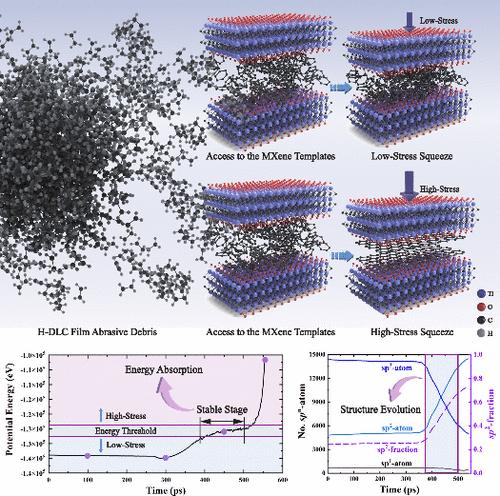以 MXene 为模板将无定形碳原位转变为类似石墨的结构,实现快速持久的超润滑性
IF 8.3
2区 材料科学
Q1 MATERIALS SCIENCE, MULTIDISCIPLINARY
引用次数: 0
摘要
由于二维(2D)材料容易发生结构变形、承载能力有限、氧化和热降解,因此在高应力条件下实现二维(2D)材料的快速和持久超润滑性具有挑战性。本研究利用 MXene 和 H-DLC 的复合材料引入了一种创新策略,在高应力条件下,H-DLC 成为优先吸能相。MXene 可作为模板,将吸收的能量快速、持续地转化为类石墨烯结构,形成原位异质 MXene/ 类石墨烯界面。这一过程实现了持久的宏观超润滑性。摩擦测试表明,在高应力条件下(∼1.5 GPa 赫兹压力),复合薄膜的摩擦系数(CoF)迅速下降到∼0.003 的宏观超润滑状态,摩擦寿命是原始 H-DLC 薄膜的十倍以上。深入的实验研究和以摩擦学为重点的分子动力学模拟表明,从分解的 H-DLC 中扩散出来的碳原子在高接触应力下形成类石墨烯结构,然后演变成类似 MXene/ 石墨烯的异质结构。分子动力学模拟显示,这种异质结构的形成涉及从 sp3 碳结构到 sp2 碳结构的转变,并伴随着显著的能量吸收。我们的研究展示了迄今为止 MXene 或 MXene/H-DLC 纳米复合材料达到的最低 CoF。本文章由计算机程序翻译,如有差异,请以英文原文为准。

In Situ Transition of Amorphous Carbon to Graphite-like Structures Using MXene as a Template for Fast and Long-Lasting Macrosuperlubricity
Achieving fast and long-lasting superlubricity in two-dimensional (2D) materials under high-stress conditions is challenging due to their susceptibility to structural deformations, limited load-bearing capacity, oxidation, and thermal degradation. This study introduces an innovative strategy by utilizing a composite of MXene and H-DLC, where, under high-stress conditions, H-DLC acts as a preferential energy-absorbing phase. MXene serves as a template to rapidly and continuously transform the absorbed energy into graphene-like structures, forming an in situ heterogeneous MXene/graphene-like interface. This process achieves long-lasting macroscopic superlubricity. Friction tests indicate that, under high-stress conditions (∼1.5 GPa Hertz pressure), the coefficient of friction (CoF) of the composite films rapidly decreases to macroscopic superluberic regimes of ∼0.003, with a friction lifespan more than ten times that of the original H-DLC films. In-depth experimental research and tribology-focused molecular dynamics simulations have shown that carbon atoms diffusing from decomposed H-DLC form graphene-like structures under high contact stress, which then evolve into MXene/graphene-like heterostructures. Molecular dynamics simulations reveal that the formation of this heterostructure involves a transition from sp3 to sp2 carbon structures, accompanied by significant energy absorption. Our research presents the lowest CoF achieved by MXene or MXene/H-DLC nanocomposite so far.
求助全文
通过发布文献求助,成功后即可免费获取论文全文。
去求助
来源期刊

ACS Applied Materials & Interfaces
工程技术-材料科学:综合
CiteScore
16.00
自引率
6.30%
发文量
4978
审稿时长
1.8 months
期刊介绍:
ACS Applied Materials & Interfaces is a leading interdisciplinary journal that brings together chemists, engineers, physicists, and biologists to explore the development and utilization of newly-discovered materials and interfacial processes for specific applications. Our journal has experienced remarkable growth since its establishment in 2009, both in terms of the number of articles published and the impact of the research showcased. We are proud to foster a truly global community, with the majority of published articles originating from outside the United States, reflecting the rapid growth of applied research worldwide.
 求助内容:
求助内容: 应助结果提醒方式:
应助结果提醒方式:


